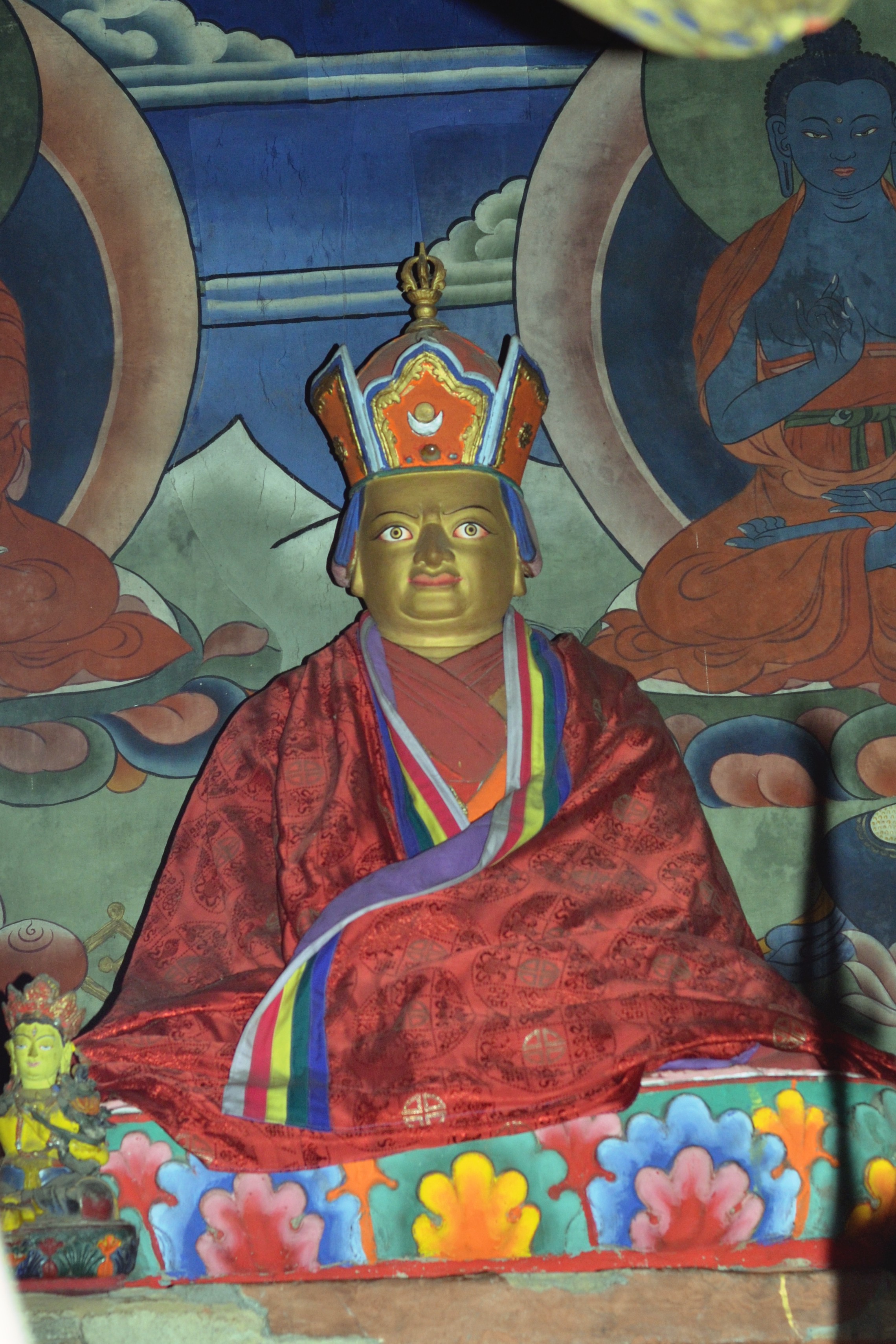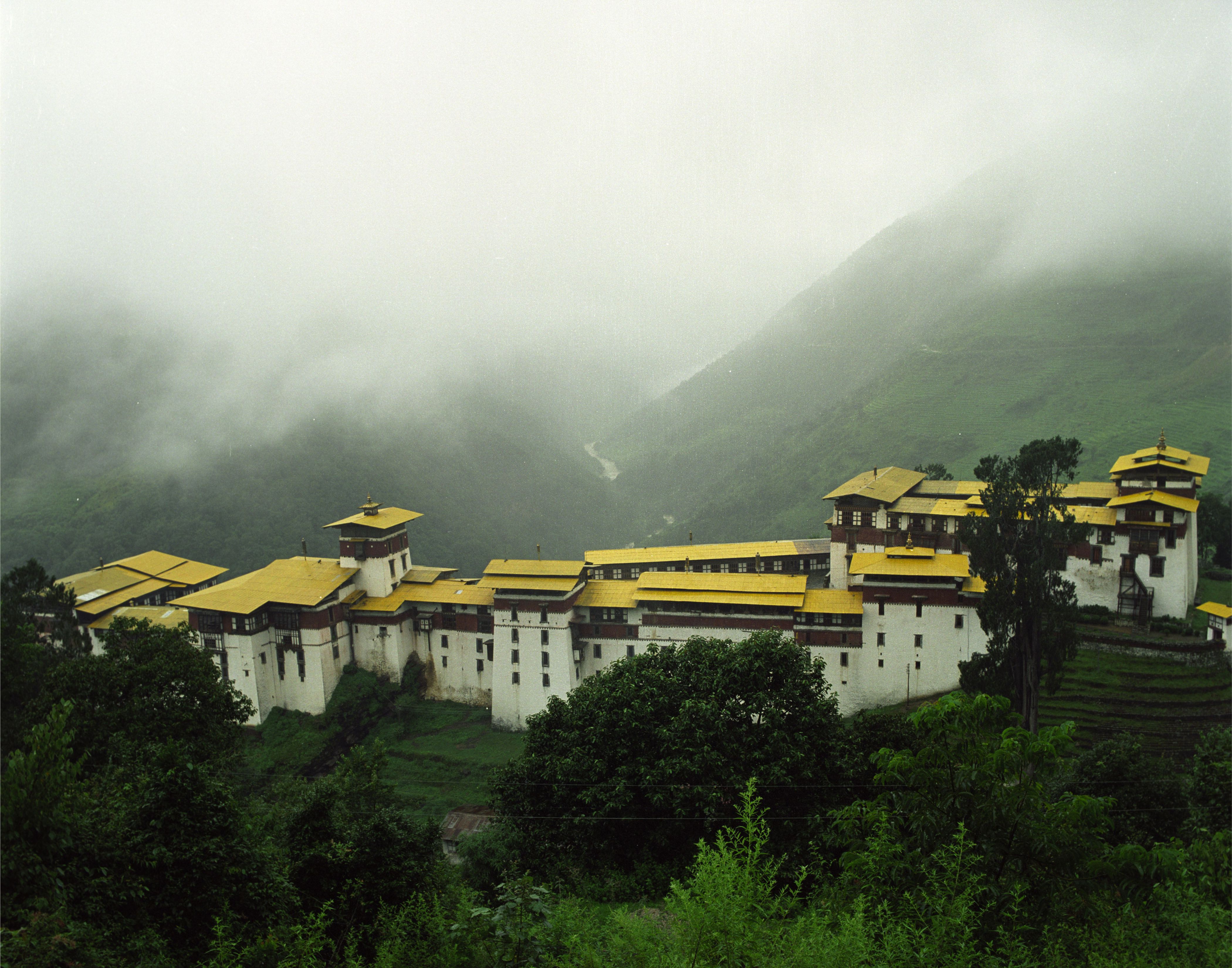|
Membartsho
Membartsho (Dzongkha མེ་འབར་མཚོ།), also known as Mebar Tsho, is a holy site, revered as the place where Pema Lingpa, Bhutan's greatest tertön (treasure discoverer), discovered several of Guru Rinpoche's terma in the 15th century. The pool in the Tang Valley, near Bumthang in central Bhutan is known locally as the Burning Lake, because according to legend, Pema Lingpa had a dream urging him to go to that particular spot in the Tang Chuu river. After standing on the rocks looking into the depths he discerned there was a temple at the bottom with many doors, one of which was open. He dove in and swam into a large cave where a woman with one eye handed him a treasure chest. As he took it from her he found himself back on dry land. The local citizens and the ruling Penlop were cynical of his claims, so he invited them to return with him and he would retrieve another terma. Holding a lit lamp, he told the assembled crowd, "If I am a genuine revealer of treas ... [...More Info...] [...Related Items...] OR: [Wikipedia] [Google] [Baidu] |
Membartsho Lake In Tang Valley, Central Bhutan
Membartsho (Dzongkha མེ་འབར་མཚོ།), also known as Mebar Tsho, is a holy site, revered as the place where Pema Lingpa, Bhutan's greatest tertön (treasure discoverer), discovered several of Padmasambhava, Guru Rinpoche's Terma (religion), terma in the 15th century. The pool in the Tang Valley, near Jakar, Bumthang in central Bhutan is known locally as the Burning Lake, because according to legend, Pema Lingpa had a dream urging him to go to that particular spot in the Tang Chuu river. After standing on the rocks looking into the depths he discerned there was a temple at the bottom with many doors, one of which was open. He dove in and swam into a large cave where a woman with one eye handed him a treasure chest. As he took it from her he found himself back on dry land. The local citizens and the ruling Penlop were cynical of his claims, so he invited them to return with him and he would retrieve another terma. Holding a lit lamp, he told the assembled crowd, ... [...More Info...] [...Related Items...] OR: [Wikipedia] [Google] [Baidu] |
Tang Valley
Tang Valley is one of the four valleys of Bumthang District, Bhutan. It is located 11 km away from Jakar, the administrative center of Bumthang District, Bhutan. It trails higher up the lake called Mebartsho. Etymology Guru Rinpoche Padmasambhava ("Born from a Lotus"), also known as Guru Rinpoche (Precious Guru) and the Lotus from Oḍḍiyāna, was a tantric Buddhist Vajra master from India who may have taught Vajrayana in Tibet (circa 8th – 9th centuries)... According ... in his attempt to subdue Khikha Rathoe, a son of Trisong Detsen, flew Khikha Rathoe and his ministers on a wooden aeroplane. As the aeroplane flew higher it caught on fire and Guru Rimpoche landed it on a rock at a valley in Bumthang. It is believed that the valley was named after the sound the aeroplane made on landing: 'Tang'. Wangdi, Nima. “Palace of the Exiled Tibetan Prince.” Kuensel Online, Kuensel, 27 Dec. 2016, https://kuenselonline.com/palace-of-the-exiled-tibetan-prince/. Refe ... [...More Info...] [...Related Items...] OR: [Wikipedia] [Google] [Baidu] |
The Nuns Of Pema Tekchok Choling Nunnery
''The'' () is a grammatical article in English, denoting persons or things that are already or about to be mentioned, under discussion, implied or otherwise presumed familiar to listeners, readers, or speakers. It is the definite article in English. ''The'' is the most frequently used word in the English language; studies and analyses of texts have found it to account for seven percent of all printed English-language words. It is derived from gendered articles in Old English which combined in Middle English and now has a single form used with nouns of any gender. The word can be used with both singular and plural nouns, and with a noun that starts with any letter. This is different from many other languages, which have different forms of the definite article for different genders or numbers. Pronunciation In most dialects, "the" is pronounced as (with the voiced dental fricative followed by a schwa) when followed by a consonant sound, and as (homophone of the archaic pr ... [...More Info...] [...Related Items...] OR: [Wikipedia] [Google] [Baidu] |
Offerings By The
Offerings may refer to: * ''Offerings'' (film), a 1989 American slasher film * ''Offerings'' (Typhoon album), 2018 * '' Offerings: A Worship Album'', by Third Day, 2000 * ''Offerings'', a 1998 album by Vas See also * Offering (other) {{disambiguation ... [...More Info...] [...Related Items...] OR: [Wikipedia] [Google] [Baidu] |
Pema Lingpa
Pema Lingpa or Padma Lingpa (, 1450–1521) was a Bhutanese saint and siddha of the Nyingma school of Tibetan Buddhism. He is considered a ''terchen'' or "preeminent tertön" (, discoverer of spiritual treasures) and is considered to be foremost of the "Five Tertön Kings" (). In the history of the Nyingma school in Bhutan, Pema Lingpa is second only in importance to Padmasambhava. Biography Pema Lingpa was born in Chel presently called Baribrang in Tang valley of Bumthang, part of the central Bhutanese region of Bumthang known as the “Wheel of Dharma.” His father was Lama Döndrup Zangpo of the Nyö clan, and his mother, Drogmo Pema Drolma, was bestowed with all the signs of a dakini. Their son was born among many miraculous signs. As an incarnation of the Omniscient One Drimé Ozer (Longchenpa), Pema Lingpa was extraordinary even as a child. He learned everything from reading and writing to ironwork and carpentry without receiving any instruction. On the tenth day of th ... [...More Info...] [...Related Items...] OR: [Wikipedia] [Google] [Baidu] |
Bhutan
Bhutan (; dz, འབྲུག་ཡུལ་, Druk Yul ), officially the Kingdom of Bhutan,), is a landlocked country in South Asia. It is situated in the Eastern Himalayas, between China in the north and India in the south. A mountainous country, Bhutan is known as "Druk Yul," or "Land of the Thunder Dragon". Nepal and Bangladesh are located near Bhutan but do not share a land border. The country has a population of over 727,145 and territory of and ranks 133rd in terms of land area and 160th in population. Bhutan is a Constitutional Democratic Monarchy with King as head of state and Prime Minister as head of government. Mahayana and Vajrayana Buddhism is the state religion and the Je Khenpo is the head of state religion. The subalpine Himalayan mountains in the north rise from the country's lush subtropical plains in the south. In the Bhutanese Himalayas, there are peaks higher than above sea level. Gangkhar Puensum is Bhutan's highest peak and is the highest uncl ... [...More Info...] [...Related Items...] OR: [Wikipedia] [Google] [Baidu] |
Tertön
Tertön () is a term within Tibetan Buddhism meaning a person who is a discoverer of ancient hidden texts or '' terma''. Many tertöns are considered to be incarnations of the twenty five main disciples of Padmasambhava (Guru Rinpoche), who foresaw a dark time in Tibet. He and his consort Yeshe Tsogyal hid teachings to be found in the future to benefit beings. A vast system of transmission lineages developed. Scriptures from the Nyingma school were updated by terma discoveries, and terma teachings have guided many Tibetan Bon and Buddhist practitioners. The Termas are sometimes objects like statues, and can also exist as dharma texts and experiences. Tertöns discover the texts at the right time and place. The teachings can be relatively simple transmissions as well as entire meditation systems. Termas are found in rocks, water and the minds of incarnations of Guru Rinpoche's students. Prominent Nyingma tertöns According to generally accepted history, the rediscovering of terma b ... [...More Info...] [...Related Items...] OR: [Wikipedia] [Google] [Baidu] |
Padmasambhava
Padmasambhava ("Born from a Lotus"), also known as Guru Rinpoche (Precious Guru) and the Lotus from Oḍḍiyāna, was a tantric Buddhist Vajra master from India who may have taught Vajrayana in Tibet (circa 8th – 9th centuries)... According to some early Tibetan sources like the ''Testament of Ba'', he came to Tibet in the 8th century and helped construct Samye Monastery, the first Buddhist monastery in Tibet. However, little is known about the actual historical figure other than his ties to Vajrayana and Indian Buddhism. Padmasambhava later came to be viewed as a central figure in the transmission of Buddhism to Tibet. Starting from around the 12th century, hagiographies concerning Padmasambhava were written. These works expanded the profile and activities of Padmasambhava, now seen as taming all the Tibetan spirits and gods, and concealing various secret texts ('' terma'') for future tertöns. Nyangral Nyima Özer (1124–1192) was the author of the ''Zangling-ma'' (Jew ... [...More Info...] [...Related Items...] OR: [Wikipedia] [Google] [Baidu] |
Terma (religion)
Terma (; "hidden treasure") are various forms of hidden teachings that are key to Vajrayana and Tibetan Buddhist and Bon spiritual traditions. In the Vajrayana Nyingma school tradition, two lineages occur: an oral ''kama'' lineage and a revealed ''terma'' lineage. Tradition holds that ''terma'' teachings were originally esoterically hidden by eighth-century Vajrayana masters Padmasambhava and Yeshe Tsogyal, to be discovered at auspicious times by treasure revealers known as tertöns. As such, terma represent a tradition of continuous revelation in Vajrayana and Tibetan Buddhism. Tradition Tradition holds that terma may be a physical object such as a text or ritual implement that is buried in the ground, hidden in a rock or crystal, secreted in a herb, or a tree, hidden in water, or hidden in the sky or in space. Though a literal understanding of ''terma'' is "hidden treasure", and sometimes refers to objects that are hidden away, the teachings associated should be understood as bei ... [...More Info...] [...Related Items...] OR: [Wikipedia] [Google] [Baidu] |
Jakar
Jakar ( Dzongkha: བྱ་ཀར་; Wylie: ''Bya-kar'') is a town in the central-eastern region of Bhutan. It is the district capital ( dzongkhag thromde) of Bumthang District and the location of Jakar Dzong, the regional dzong fortress. The name Jakar roughly translates as "white bird" in reference to its foundation myth, according to which a roosting white bird signalled the proper and auspicious location to found a monastery around 1549. History The town is the site of Chakhar Lhakhang, a small and unassuming temple which marks the site of the "Iron Palace" of Sindhu Raja, the Indian monarch who is believed to have first invited Guru Rinpoche to Bhutan in 746. The current building is said to have been constructed by Tertön Dorje Lingpa in the 14th century. According to the Jakar foundation myth, a roosting white bird signaled the proper and auspicious location to found a monastery around 1549. The settlement thus earned the moniker Jakar, meaning "white bird." There a ... [...More Info...] [...Related Items...] OR: [Wikipedia] [Google] [Baidu] |
Penlop
Penlop ( Dzongkha: དཔོན་སློབ་; Wylie: ''dpon-slob''; also spelled Ponlop, Pönlop) is a Dzongkha term roughly translated as governor. Bhutanese penlops, prior to unification, controlled certain districts of the country, but now hold no administrative office. Rather, penlops are now entirely subservient to the House of Wangchuck. Traditionally, Bhutan comprised nine provinces: Trongsa, Paro, Punakha, Wangdue Phodrang, Daga (also Taka, Tarka, or Taga), Bumthang, Thimphu, Kurtoed (also Kurtoi, Kuru-tod), and Kurmaed (or Kurme, Kuru-mad). The Provinces of Kurtoed and Kurmaed were combined into one local administration, leaving the traditional number of governors at eight. While some lords were penlops, others held the title Dzongpen ( Dzongkha: རྗོང་དཔོན་; Wylie: ''rjong-dpon''; also "Jongpen," "Dzongpön"), a title also translated as "governor." Other historical titles, such as "Governor of Haa," were also awarded. Under the dual syste ... [...More Info...] [...Related Items...] OR: [Wikipedia] [Google] [Baidu] |


.png)



